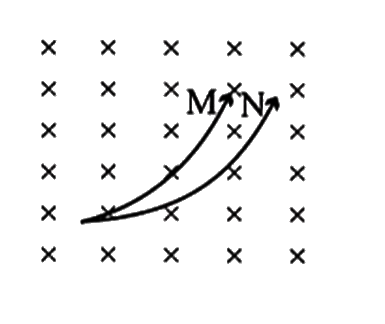Two charges particles tranverse identical helical paths in a completely opposite sense in a uniform magnetic field B=B0ˆk.
They have equal z-components of momenta
They must have equal charges
They necessarily represent a particle-antiparticle pair
The charge to mass ratio satisfy
(em)1+(em)2=0
The correct Answer is:D
Step by step video & image solution for Two charges particles tranverse identical helical paths in a completely opposite sense in a uniform magnetic field B=B_(0)hatk. by Physics experts to help you in doubts & scoring excellent marks in Class 12 exams.
Topper's Solved these Questions
- BOOK - AAKASH SERIESCHAPTER - MOVING CHARGES AND MAGNETISMEXERCISE - EXERCISE-IB71videos
MOVING CHARGES AND MAGNETISM
- BOOK - AAKASH SERIESCHAPTER - MOVING CHARGES AND MAGNETISMEXERCISE - EXERCISE-II79videos
MOVING CHARGES AND MAGNETISM
- BOOK - AAKASH SERIESCHAPTER - MOVING CHARGES AND MAGNETISMEXERCISE - EXERCISE-III49videos
MOVING CHARGES AND MAGNETISM
- BOOK - AAKASH SERIESCHAPTER - MOTION IN A STRAIGHT LINE EXERCISE - very Short answer type question15videos
MOTION IN A STRAIGHT LINE
- BOOK - AAKASH SERIESCHAPTER - NUCLEAR PHYSICSEXERCISE - ADDITIONAL PRACTICE PRACTICE SHEET (ADVANCED) Integer Type Questions3videos
NUCLEAR PHYSICS
Similar Questions
Knowledge Check
- Question 1 - Select One
Two charged particles traverse identical helical paths in a completely opposite sense in a uniform magnetic field →B=B0ˆK
AThey have equal z−components of momenta.BThey must have equal charges.CThey necessarily represent a particle-antiparticle pair.DThe charge to mass ratio satisfy:
(em)1+(em)2=0.
A charged particle moves in a uniform magnetic field B=(2ˆi−3ˆj) T
View SolutionWhen would a moving charged particle travel undeviated in a uniform magnetic field ?
View SolutionThe path of a charged particle moving in a uniform steady magnetic field cannot be a
View SolutionA charged particle moving along +ve x-direction with a velocity v enters a region where there is a uniform magnetic field B0(−ˆk),omx=0→x=d. The particle gets deflected at an angle θ from its initial path. The specific charge of the particle is
 View Solution
View SolutionTwo charged particle M and N are projected with same velocity in a uniform magnetic field. Then M and N respectively.
 View Solution
View SolutionIf a charged particle enters perpendicular in the uniform magnetic field then
View SolutionA charged particle (q.m) released from origin with velocity v=v0ˆi in a uniform magnetic field B=B02ˆi+√3B02ˆJ.
Pitch of the helical path described by the particle isView Solution

